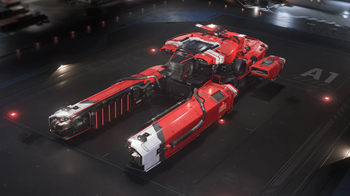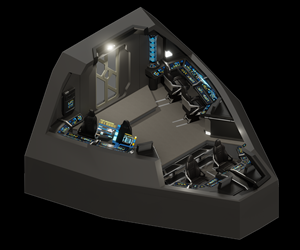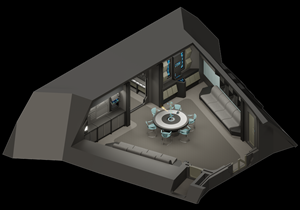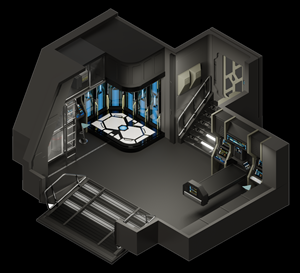Kaplan S47 Salvage Vessel
Created by Captain Luzol Targaryen on Mon Feb 24th, 2025 @ 2:54am
General Overview
Kaplan S-47 Salvage Vessel Sulaco
"Sulaco" |
|
|---|---|
 | |
| Affiliation: | Private Ownership |
| Length: | 67.2 meters |
| Width: | 32.7 meters |
| Height: | 12.9 meters |
| Decks: | 3 |
| Crew: | 7 personnel 6 passengers 45 emergency |
| Speed: | Warp 7.2 |
| Armament: | Pulse Disruptor Turret |
| Defenses: | Deflector Shields |
Technical Data
Physical Arrangement
The Kaplan S-47 is a light salvage vessel is a stock salvage shup produced by the Kaplan Engineering Corporation. The S-47 maintains many of the classic features present in all Kaplan designs since the 23rd Century, but is unique due to the inclusion of an integrated resource processing system along the forward hull of the craft. This gives the S-47 an industrial grade Tractor Beam system that is more powerful than its counterparts on Federation Heavy Cruisers and a Cargo Hold capable of transporting being almost 500 metric tons of resources.
Propulsion Systems
Hyper Impulse Drive
A Hyper Impulse Engine is an advanced propulsion system that is used by spacecraft for slower-than-light maneuvers in space.The Impulse Drive is essentially an augmented fusion rocket that consists of fusion reactors, a driver coil assembly, and a vectored thrust nozzle to direct the plasma exhaust from the fusion reaction. While the highly energized plasma produced by the fusion reaction was used to supply power to shipboard systems, when passed through the driver coils the energy had a further benefit of producing a subspace field that improved the propulsive effect. Hyper Impulse Engines utilize this subspace field to allow the craft to successfully travel at higher sublight speeds without risking triggering a relativistic effect that would slow time for the crew while time traversed normally for those outside the ship.
For precise maneuvering at high speeds the Impulse Engines on the Kaplan S-47 Salvage Vessel have been placed on gimbals that move in response to flight directives.
Warp Drive
The linchpin of an interstellar civilization, Warp Drive made trade and exploration across vast interstellar distances a viable prospect within the galaxy.The Warp Engines of the Kaplan S-47 Salvage Vessel are fueled by the reaction of matter (deuterium) and antimatter (antideuterium), mediated through an assembly of dilithium crystals, which were nonreactive with antimatter when subjected to high-frequency electromagnetic fields. This reaction produced a highly energetic plasma, called electro-plasma or warp plasma, which was channeled by plasma conduits through the electro-plasma system (EPS); that system also provided the primary energy supply for the ships other electronic systems. For propulsion the electro-plasma was funneled by plasma injectors into a series of warp field coils, usually located in remote warp nacelles. These coils were composed of verterium cortenide and generated the warp field.
As mentioned, dilithium regulates the matter/antimatter reaction that is used to produce the Warp Field. Following the Burn in 3069 the usage of Warp Drive has become highly restrictive in the Milky Way Galaxy due to most dilithium supplies having become inert within the Alpha and Beta Quadrants. While outdated, the Kaplan S-47 makes up for this deficit through a tightly controlled reaction requiring less dilithium, but even it is not immune from the loss of suitable dilithium stores within the galaxy.
Scientific Systems
The Sensors of the Kaplan S-47 Salvage Vessel are highly sophisticated for a starship its size and were used to scan, record, or otherwise observe any aspect of an environment surrounding the starship. Each sensor created data that was interpreted by the vessels' computers and operators, revealing information that was not apparent through other data-collecting means.There were two basic types of sensor arrays employed: passive and active. A passive scan was less obtrusive than an active scan, and might not be detected by the subject being sensed. Sensors were divided further into short- and long-range types, and low- and high-energy types with a maximum operational range for the S-47's sensors being 15 light-years for a low resolution scan.
Tactical Systems
Defensive Systems
Deflector Shields are the primary defense for the Kaplan S-47 Salvage Vessels and are used to protect against enemy attacks or natural hazards.Shields operate by creating layers of energetic distortion with a high concentration of gravitons around ship and are emitted by a localized network of emitters. Under standard operations neither matter nor energy could penetrate a shield and was harmlessly deflected away when shields were engaged; nonetheless, Shields used a frequency range to allow certain types of energy and matter to pass through. Continuous or extremely powerful energy discharges could gradually erode a shield's integrity to the point of failure and would expose the hull of the vessel to potential catastrophic damage; however, sections of the shield grid could be reinforced with additional power reserves if necessary.
Offensive Systems
Standard configuration Kaplan S-47 Salvage Vessels are launched without offensive capabilities but maintain a high-capacity deflector shield emitter that is used for defensive purposes. Despite this, Kaplan Engineering Corporation built the S-47 with four weapon emplacement points designed for aftermarket conversion kits allowing for the incorporation of offensive weaponry into the vessel's hull.While an older model, the Sulaco has been upgraded with a single Pulse Disruptor Turret atop the vessel's hull. Salvaged from the Ni'Varian vessel Votantius, the Pulse Disruptor Turret disrupts the bonds of atoms on impact in a series of rapid pulses. The Pulse Disruptor Turret aboard the Sulaco is not normally encountered on a vessel its size, making it a dangerous opponent on the battlefield, despite a slightly diminished discharge rating compared to its counterparts.
Interior Design
Cockpit
 The Kaplan S-47 Salvage Vessel is controlled from a spacious cockpit located on the forward edge of the uppermost level.
The Kaplan S-47 Salvage Vessel is controlled from a spacious cockpit located on the forward edge of the uppermost level. Located at the front of the cockpit in a sunken pit beneath large, panoramic windows were twin workstations that were traditionally assigned to oversee the flight operations of the salvage vessel. The forward port workstation was commonly assigned to the Captain of the vessel and was sophisticated enough to allow for single-pilot salvage operations should the need arise. Typically, the console on the starboard side would be assigned to oversee flight control and navigational functions aboard the vessel. While heavily automated the pilot could take manual control in an emergency, but this was a rare occurrence.
Four configurable workstations were available in the rear section of the Cockpit. During standard salvage operations at least two workstations would be assigned to monitor sensor scans for valuable components or materials that could be brought aboard the ship. The remaining workstations would be used to manage shipboard maintenance while the other would incorporate tactical functions. Small square viewscreens were mounted within the forward corners of this section of the Cockpit that served as ship status displays. A large porthole was located above the twin workstations that were further equipped with retractable blast shutters for added protection.
Crew Cabins
 Located on both the upper and lower decks of the Kaplan S-47 Salvage Vessel, Crew Cabins aboard the ship were the among the barest accommodations in the galaxy, neither sizeable nor aesthetically laid-out when compared to quarters on other ships in the galaxy. Despite this, the cabins aboard the Kaplan S-47 were capable for the short-term nature of the vessel's missions and featured four stacking bunks fitted into the walls of each cabin for use by passengers and crew. A single computer terminal was built into the bulkhead of each bunk for use by the crew. A shared restroom was attached to each cabin aboard the S-47, which included a sink, sonic shower, and toilet.
Located on both the upper and lower decks of the Kaplan S-47 Salvage Vessel, Crew Cabins aboard the ship were the among the barest accommodations in the galaxy, neither sizeable nor aesthetically laid-out when compared to quarters on other ships in the galaxy. Despite this, the cabins aboard the Kaplan S-47 were capable for the short-term nature of the vessel's missions and featured four stacking bunks fitted into the walls of each cabin for use by passengers and crew. A single computer terminal was built into the bulkhead of each bunk for use by the crew. A shared restroom was attached to each cabin aboard the S-47, which included a sink, sonic shower, and toilet.
Captain's Cabin
The Captain's Cabin on the Kaplan S-47 Salvage Vessel was located on the starboard side of the upper deck. Sharing the same basic layout as cabins assigned to the crew, the Captain's Cabin is different in that it features only a single bed built into the forward bulkhead. The aft bulkhead incorporates a built-in desk with large wall mounted display that is used to monitor operations aboard the vessel or for entertainment purposes. The Captain's Cabin also provides the Captain a place to meet with the crew in privacy.
Crew Lounge
 Located in the forward compartment of the lower deck, the Kaplan S-47 Salvage Vessel's Crew Lounge was the primary social center aboard the vessel and was commonly used by the crew for entertainment purposes.
Located in the forward compartment of the lower deck, the Kaplan S-47 Salvage Vessel's Crew Lounge was the primary social center aboard the vessel and was commonly used by the crew for entertainment purposes. The Crew Lounge was commonly used for dining and entertainment purposes, incorporating a replicator that can provide any food which has been programmed into the vessel’s database. The focal point of the room is a large, circular table that provides seating for up to six people. Holographic emitters were directly integrated into the table, allowing for briefing displays and entertainment to be presented directly through the table itself.
Three large windows were fitted both sides of the compartment, providing natural lighting while the vessel is landed or traveling near stellar phenomena. Large couches were built into the bulkhead beneath the windows that could be used for relaxation by passengers. Twin doors along the forward port and starboard walls allow access to the midlevel salvage equipment at the front of the ship, while a third door located in the center of the forward bulkhead allows access to the propulsion systems.
Hold
 Located in the aft compartment of the lower deck, the Kaplan S-47 Salvage Vessel's Hold supports multiple responsibilities aboard the spacecraft.
Located in the aft compartment of the lower deck, the Kaplan S-47 Salvage Vessel's Hold supports multiple responsibilities aboard the spacecraft.The port side of the Hold is assigned to maintain Cargo and Transport functions aboard the salvage ship. The dominant feature of this portion of the Hold was a large combination cargo and personnel transporter. Featuring an operational range of around 40,000 kilometers, the transporter is also able to transport delicate salvage, scientific specimens, and bulk cargo supplies.
The starboard side of the Hold incorporates a retractable biobed that is useful for medical situations; however, despite this inclusion, the medical capabilities were limited and focused more on stabilization until a patient could be taken for additional treatment. Enhanced sensor equipment was installed in the overhead lighting cluster and holoemitters allowed for the usage of an Emergency Medical Hologram for situations in which a doctor were unavailable. The compartment is further fitted with specialized laboratory equipment that can be used in salvage operations.
Categories: No categories found